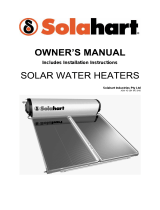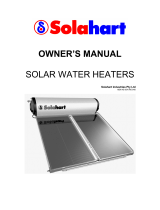
INSTALLATION AND OPERATION MANUAL SOLAR MODULES SOLAHART400S4 3
1 Introduction
With solar modules from Solahart Industries Pty Ltd. (hereafter
referred to as "Solahart") you can directly transform the sun’s
limitless energy into environmentally-friendly solar electricity.
In order to ensure the maximum performance of your Solahart
solar modules, please read the following instructions carefully
and observe all guidelines. Non-compliance may result in
damage and / or physical injury.
This installation and operation manual (hereafter also referred to
as the “Manual”) provides instructions for the safe installation and
operation of crystalline solar modules.
Please read these instructions carefully before proceeding with
your installation.
Please retain these instructions for the life of the solar modules.
Please ensure that this Manual is available to the operator at all
times.
This Manual should be given to all subsequent owners or users
of the solar modules.
All supplements received from the manufacturer should be
included.
Please observe all other applicable documents.
If your questions are not satisfactorily answered in the manual,
please contact your system supplier.
Additional information can be found on our website.
Intended use
This manual is valid for Australia and New Zealand. These
instructions contain information regarding the safe handling and
use of quality crystalline solar modules from Solahart and their
installation, mounting, wiring, maintenance and disposal.
Symbols and Labels
The following symbols and labels are used throughout the
Manual for ease of use.
SYMBOL DESCRIPTION
Procedure with one or more steps.
Lists of items.
Ensure that when carrying out a procedure,
you check the results of said procedure.
Prohibited.
Beware of possible danger or damage.
Categories:
■Danger: Risk of fatal injury
■Attention: Risk of serious injury or damage to
property
■Note: Risk of damage to product
Safety Regulations
In particular the installer as well as the operator of a module
is responsible for compliance with all applicable statutory
requirements and regulations.
Unless otherwise specified by any laws or regulations, the
following stipulations must be upheld at all times during the
installation, operation, and maintenance of the solar modules:
■This manual.
■Other applicable stipulations (such as country-specific
regulations for pressure equipment, operational safety,
hazardous goods, and environmental protection).
■Regulations and requirements specific to the system.
■Any applicable laws and requirements, in particular
international, country specific, regional laws and stipulations
governing the planning, installation, and operation of solar
power systems and work on roofs.
■Any valid international, national and regional regulations
governing work with direct current, especially those
applicable to the installation of electrical devices and
systems, and regulations issued by the respective energy
provider governing the parallel operation of solar power
systems.
■Any international, country specific and regional accident-
prevention regulations.
■Other applicable stipulations provided by the relevant
national institutions regarding safety in the installation and
operation of electrical items.
Qualified and Skilled Personnel
Both, the installer and operator are responsible for ensuring that
the installation (including connection to the grid), maintenance
and dismantling are carried out by trained and qualified
specialists with approved training certificates (issued by a state
or federal organization) for the respective specialist trade. In
Australia, electrical work may only be performed by a CEC
accredited licensed electrician complying with valid accident
prevention regulations of the local energy provider(s). In New
Zealand, electrical work may only be performed by a skilled
electrician complying with valid accident prevention regulations,
and the regulations of local grid operator and/or energy provider.




























